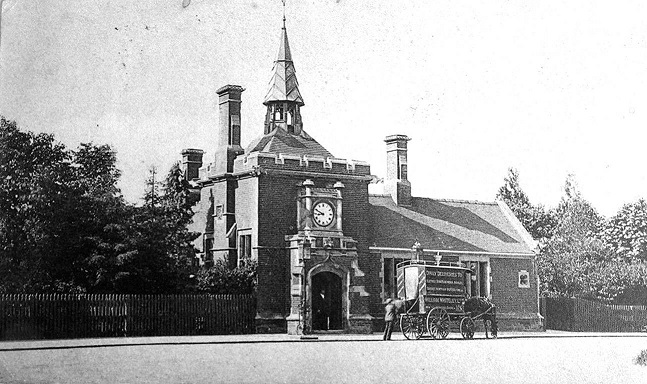The Stanmore branch line, two miles and three furlongs in length, extended from LNWR Harrow and Wealdstone station through the Middlesex countryside to the village of Great Stanmore. This affords yet another example of private enterprise which in the past has provided so many towns and villages its means of transit and in most cases their very existence.
Origins
The Harrow and Stanmore railway line owes its origins to just one man.. the world’s greatest Hotelier Mr. Frederick Gordon who in 1882 purchased Bentley Priory with the intention to open it up as a country retreat for the wealthy few to come and enjoy some peace and quiet and fresh air in the Stanmore countryside. Stanmore at the time had a population of some 1400 but no direct rail links with London, hotel guests would have to be coached up and with the roads in a worse condition than we enjoy today a railway was the only answer
Gordon proposed a preliminary plan of the railway during the year 1885, and Subsequently hired Mr W. B. Myers, one of the top civil engineers of his day, who was entrusted with the laying out of a line running westward of Belmont Circle via Hill House and Bamfords Corner (now Brochhurst Corner) then continued north side of Stanmore Park Mansion, in consequence thereof notice of opposition was given by the owner, but nothing daunted Mr. Gordon and thereupon decided to purchase the estate. Next the owners and residents were approached, but the result was disappointing as far as raising of capital was concerned, so ultimately therefore the London And North-Western Railway was consulted with a view to working the line and its consent was obtained on terms however, virtually requiring Mr. Gordon provide nine tenths of the required capital.
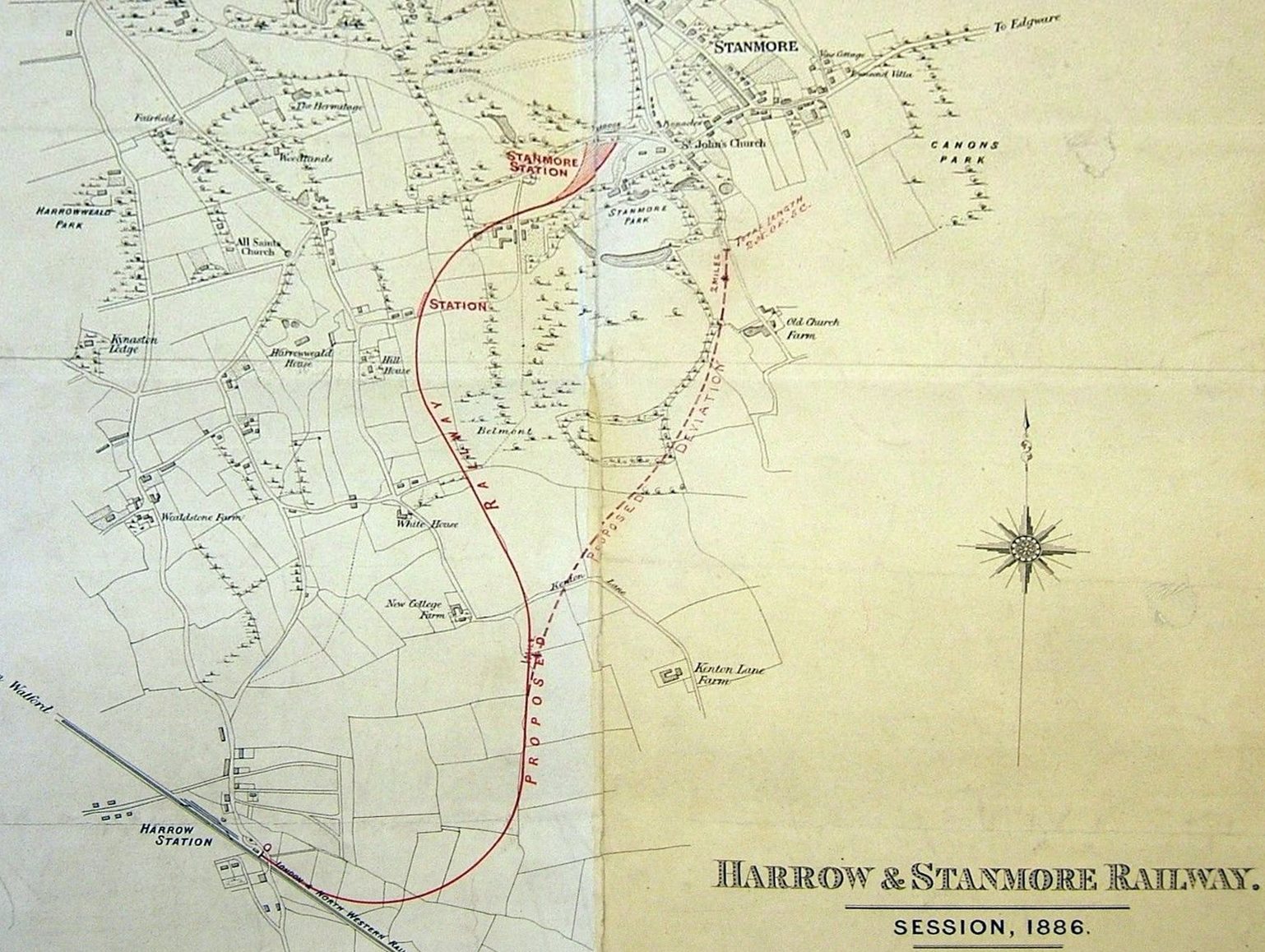
Mr. Myers was now instructed to lay a less costly line with the proviso that the beauty of the surroundings should not be destroyed in the process. Under the new scheme the railway was deviated via the rifle butts and Kenton Lane farm and then travelling east around Bell Mount, culminating at a terminus in Old Church Lane below the vicarage at a level of approximately 94 ft. above that of the junction at Harrow. The Stanmore station was designed to appease the local population and be deemed worthy of its surroundings was designed to look like a country church. In 1888 the amended route received parliamentary approval and the building commenced in July 1889. The contract was let to Mr. Chas Braddock of Wigan and the first sod was cut by Mrs. Gordon upon the site of the terminus in Stanmore.
Opening Day
On a bitterly cold Thursday December 18 1890, the line was formally opened. The inaugural train was a Webb’s 2-4-2T it is recorded proceeding from Harrow at 12:17 having its engine decorated with evergreens and the stations decked in bunting, the arrivals being greeted by merry peals from the church bells and the music of the Harrow Town Band. Visitors to the number of 400 were at the invitation of Mrs. Gordon, conveyed by road the Bentley Priory. In declaring the line open Sir George Findlay, General Manager of the London and North-Western Railway, observed that Stanmore owed much to Mr. Frederick Gordon while the latter gentleman is responding expressed the opinion that a profitable return must not be looked for in the immediate future.
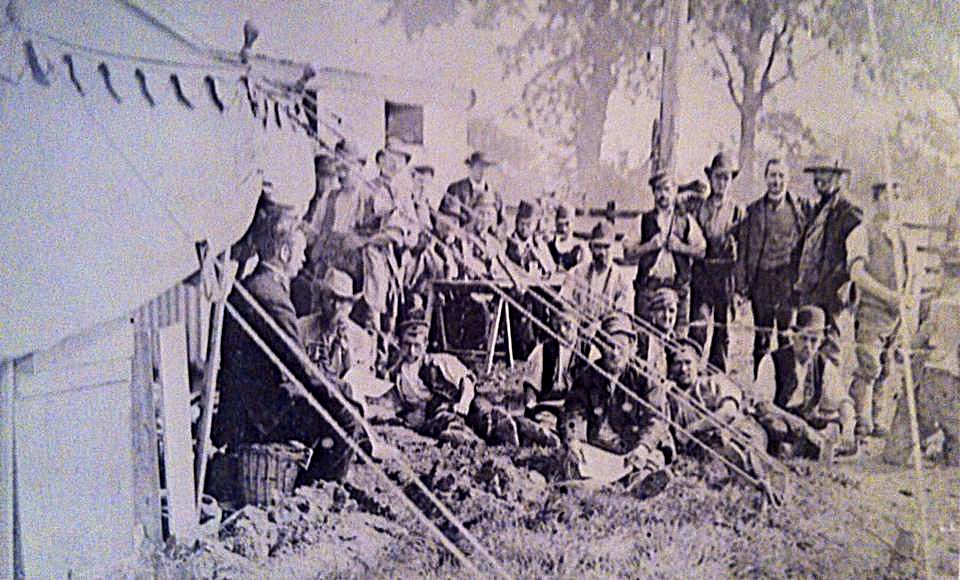
As a souvenir Lady Findlay was presented with a handsome gold brooch set in diamonds. An excellent programme of music of music was provided by the band of the Scots Guards. The bell ringers of Stanmore other men of the village as well as the contractors’ employees were given a good dinner in the new goods shed. New shillings were presented to the mothers and older women, whilst new sixpences were given to each of the school children. The day was observed in Stanmore as a general holiday and the trains we were told “thronged all day”. The railway thus inaugurated consisted of a single line of the length of two miles and three furlongs, and it is worked under the ’one staff’ system. It terminates in bay platform line at Harrow and Wealdstone upon the upside and runs parallel with the main lines Londonward for some distance. The line then took a nigh semi-circular course north eastwards passing the recreation ground, the rifle range and Belmont and then travelling through the then, still unspoilt beauty of rural Middlesex.
By the time the line had opened Gordon had laid out a road to be named after himself which became Gordon Avenue. A wide avenue to be filled with brand new superior houses hoping to attract wealthy Londoners to come and live in the country, and any thoughts of attracting visitors to his hotel seem to have taken second place. The line was only operating a Monday to Saturday service, it was Gordon himself that agreed not to run a Sunday service, presumably to stop Sunday day trippers spoiling the quiet ambience of country life, although it was agreed that this ruling could be lifted after a period of 40 years
The End of an Independent Company
A London and North-Western Railway act allowed the larger company to operate and maintain the line whilst an additional act of 1899 permitted them to buy it outright. The LNWR agreed to work the short branch with the Harrow & Stanmore Railway building and maintaining a single-track line with a passenger and goods station at Stanmore and interchange sidings at Harrow. From the beginning Staff and rolling stock would be provided by LNWR and the act also allowed for an intermediate station if requested by the LNWR. After one year the LNWR agreed to take over maintenance and repair of the line. Eventually the inevitable happened and on the 29 September 1899 The Harrow and Stanmore railway was wound up and sold to the London and North-Western Railway for £35,000.
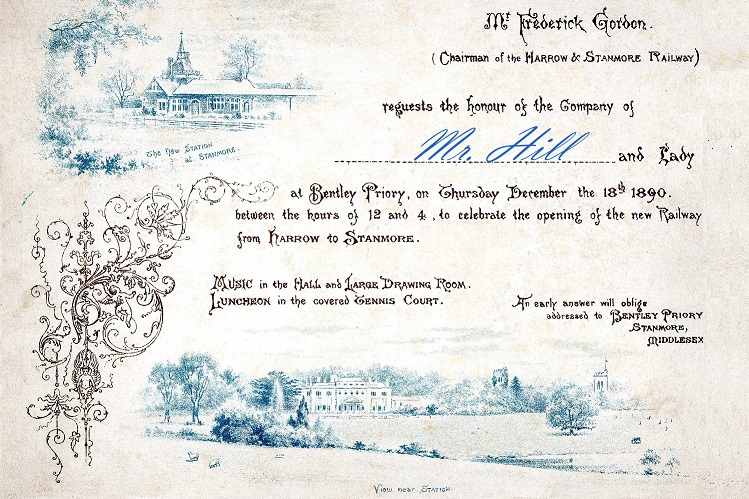
For Frederick Gordon, the Harrow and Stanmore railway and the Bentley Priory Hotel were not the great money-spinners that he had hoped for, although nothing seemed to phase Gordon and he simply moved his family in and used the priory as his country home. The Stanmore residents too benefitted from their new first class rail service. Always the businessman however Frederick was more successful with his other hotel business and made an estimated £2 million, an enormous sum at the end of the 19th century. He also dominated the west African gold market and was director of companies as diverse as Ashanti Goldfields, Apollinaris and Johannis (the mineral water company now owned by Coca Cola), Guest, Keen and Nettlefoldes (The British multinational automotive and aerospace components company now known as GKN), Maple & Co (one of the largest and most successful British furniture retailers and cabinet makers of the Victorian era), Pears soap and Bovril.
In the autumn of 1903 Frederick Gordon fell ill and was advised to take a break from work, he chose the French Riviera where he owned the Hotel Metropole in Cannes. It was here on 22 March 1904 on a night out at the opera in Monte Carlo that, "The Napoleon of the Hotel World" suffered a fatal heart attack. His death was covered by both the local and national press and his body was brought back to Great Stanmore and he is buried in the family grave at St. Johns churchyard. His wife died a year later on 27 June 1905. Gordons hotel business carried on for many years afterwards and eventually was bought up by the Grand Metropolitan chain in 1963
With Stanmore changing from rural outpost to part of suburban London the Metropolitan Railway opened their own line to Stanmore on 10 December 1932. Whereas the Stanmore Village line gave a suburban style, the new line offered commuters an easier and more comfortable journey to and from work. About this time a new halt had been added to the Stanmore branch line at Belmont, and just two years later with ever growing passenger demands, the 40-year rule on no Sunday service was up and now operated seven days a week.
The delightful little country station gave sterling service during the two world wars with virtually no disruption to services until 1946 when coal shortages once again caused the suspension of Sunday services. In 1950 the Station at Stanmore was renamed Stanmore Village so as not to confuse passengers with the new Stanmore station some distance away, but, with alternative methods of transport as well as Dr. Beeching swinging his axe, by now its days were numbered. Passenger trains were suspended to Stanmore on 15 September 1952, though a daily freight train served the goods yard at Stanmore. The passing loop was removed in 1955. The line to Stanmore was closed completely on 6 July 1964, as part of the railway cuts implemented under the Beeching Axe. Passenger services from Belmont to Harrow were withdrawn on 5 October 1964.
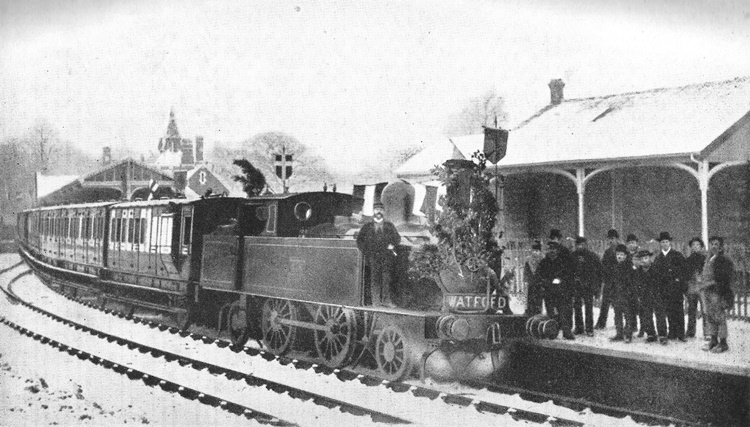
The railways that had helped Britain become an industrial power, but which were now haemorrhaging money, were to be cut back brutally. Modernisation and motorways were evidently what mattered. Beeching decreed the car would replace the train, in doing so, he ushered in an era of vast motorway expansion and cheap motorised transport. If Beeching and other transport planners of the day had had their way, only a rump of inter-city lines would have been left.
Stanmore Village station, once described at the prettiest in the country suffered its own humiliating end after closure it remained empty and vandalised. A group of local residents got together to petition for preservation order on the station building, various ideas were mooted including a rail museum, and an arts centre. The Station was sold to a local property developer in 1969, permission was finally granted to preserve the building, and turn it into a residential property, most of the original structure including the spire were removed. This act was probably the worst form of vandalism and certainly wasn’t preservation.
The Belmont trail
After the tracks were taken up in 1966 Harrow Council bought the remainder of what was left of the track bed, where it remained for many years, unused and unloved. Parts of the line were either built on or reverted back to its natural state, overgrown with bushes weeds and the undergrowth in some place making it almost impassable. The line being unattended was also a magnet for vandals and the dumping of rubbish. Various groups and charities lobbied to have the area cleaned up. A new scheme was launched to breathe new life into the line and The area from Christchurch avenue to Vernon Drive has been cleaned up courtesy of Harrow council in partnership with the London wildlife trust and renamed, ’The Belmont trail’ was born.
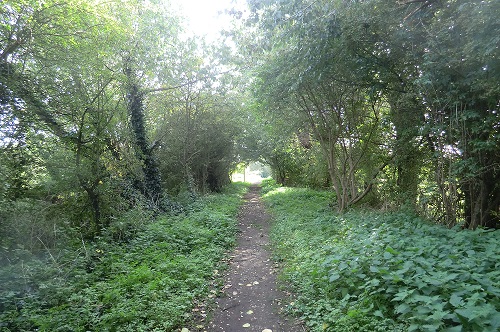
The best place to pick the trail up is in on Christchurch Avenue, by the roundabout joining Forward Drive. You are greeted by a staircase of old railway sleepers which climbs the embankment, here a bridge once stood carrying the trains on their northbound journey to Stanmore via Belmont. You can’t really get lost as it’s only a single trackway but in case you do there is plenty of trail signs letting you know you are on the right path, and there are still a few original railway markers along the route, watch out for a gradient marker and a post labelled three over four marking ¾mile from the Harrow and Wealdstone terminus. Just before you reach the Belmont Bridge you skirt Dobbin Close, so named after the Farmers donkey that was in a field where the street now stands. Steps rise up to a car park this is the site of the Belmont halt the half way point of the line, the foundations of the Station are buried under the carpark
The trail now leaves Belmont and continues towards Stanmore from the far end of the car park. The track widens up here, and there’s another five-minute walk ahead and the route ahead is blocked by the synagogue’s fence. This was the site of the Vernon Drive / Wemborough Road foot crossing, and for many years the site of the proposed Belmont By-pass, the idea now dead in the water as housed have been built in its path. There is a path to the left-hand side of the synagogue but it is quite overgrown and inaccessible at certain times of the year due to the dense foliage. You can make out a fairway from Gordons own Golf course so technically the Belmont Trail ends here. To reach the former station at the end of the line you’ll could cross the footpath over Stanmore Golf course, which is laid out over Bell Mount, a mound which gives Belmont its name.
Friends of the Belmont Trail
The recently established ’Friends of the Belmont Trail’ is a group supporting the work of locals like Mark Brooker who have been working tirelessly to develop the trail as a haven for wildlife as well as a beautiful route from Stanmore at Vernon Drive to Christchurch Avenue in Harrow. Used by walkers, locals, cyclists and dog walkers, they hope to develop the biodiversity by working with Harrow council and biologists. They also wish to celebrate the history of the route as a railway line. Parts of the Belmont station are still visible if you look hard enough!
For more information go to their website at www.belmonttrail.com or their Facebook page for the Friends of Belmont Trail.
And that is what is left of The Stanmore rattler, which is what the train and the line was affectionally known as. To Beeching and his ilk the train, deemed dirty and smoky. It was the stuff of the sooty fabric of Victorian Britain and was earmarked for extinction.
But today, with a rising population, in a country crowded with more than 34 million cars, the train companies are carrying more passengers in a year than at any time since the 1920s, and the demand for rail travel has never been higher.
